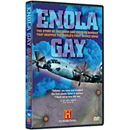The Bomb that Destroyed Hiroshima
The first nuclear weapon used in warfare was dropped on Hiroshima, Japan, on August 6, 1945. "Little Boy" was dropped from a B-29 bomber -- the Enola Gay -- piloted by U.S. Army Air Force Colonel Paul W. Tibbets. The bombardier set the control plugs to arm the 9,000-pound bomb just before it was dropped. When the bomb reached 1,850 feet, a radar echo set off an ordinary explosive inside. This drove a wedge of U-235 into a larger piece of U-235, setting off a blast with the force equal to 13,000 tons of TNT. Immediate deaths were between 70,000 and 130,000.
Three days later, a second atomic bomb, called "Fat Man," was dropped on Nagasaki.
How It Worked
"Little Boy" was what is commonly known as a "Gun-type" bomb, and actually did contain a gun. At one end of the barrel was a "target," a piece of U-235 slightly smaller than critical mass and shaped like a sphere with a conical wedge removed from it. At the other end of the barrel was another, smaller, piece of U-235 in the shape of a cone with its point towards the gap in the target. It was in the exact shape of the piece missing from the sphere. Together, the two pieces were just over critical mass. The smaller piece was backed by a charge of ordinary high explosive (a bag of cordite). When this was set off, the cone was shot into the sphere and the force of the impact welded the two pieces together solidly. The explosion followed instantly.
The "projectile" was a cylinder, about 16 cm long and 10 cm wide, with 40% of the total mass (25.6 kg). It was actually a stack of six uranium rings protected by a casing of steel, with a tungsten carbide and steel backing plate at the back end. The entire "projectile" assembly was locked in a 2 mm thick steel box. The "target" was a hollowed-out cylinder, 16 cm long and in diameter, with a 10 cm hole in the middle for the bullet, with a uranium mass of 38.4 kg.
The two parts were protected by boron casings designed to absorb the neutrons. The system of neutron reflectors was composed of steel and tungsten. This part, called the tamper, weighed 2,300 kg.
The barrel was made from a modified artillery gun barrel and breech assembly, measuring 10 cm wide and about 180 cm long, and weighing 450 kg.
1) Box tail fins
2) Steel gun breech assembly
3) Detonator
4) Cordite explosives
5) Uranium-235 projectile
6) Barometric sensing ports and manifold
7) Bomb casing wall
8) Arming and fusing equipment
9) Gun barrel
10) Arming wires
11) Tamper assembly
12) Uranium-235 target (two 38-kg rings)
13) Tamper/reflector assembly
14) Neutron initiator
15) Telemetry monitoring probes
16) Recess for the boron safety plug to be ejected into
Although occasionally used in later experimental devices, this design was only used once as a weapon because of the extreme danger of accidental detonation. A simple crash could conceivably drive the "bullet" into the "target," resulting in a massive release of radiation, if not a full-scale nuclear detonation. A lightning strike or fire could also trigger the bomb. None of the other five "gun-type" atomic bombs built on the model of "Little Boy" were used by the United States Army.
Questions or comments about this page?
![]()
"Little Boy and Fat Man." Building the
Atomic Bomb. Los Alamos National Laboratory. www.lanl.gov/history/atomicbomb/littleboyandfatman.shtml
National Atomic Museum. www.atomicmuseum.com/tour/dd2.cfm
